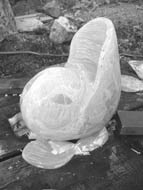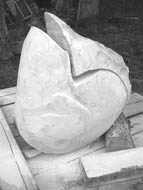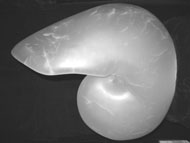McWilliam's Journal - Mar/Apr 2005
- Details
- Created: Wednesday, 02 March 2005 01:25
This little story, written for my website, is about all my stone collecting in Alaska in 2004 and not just about collecting stone for sculptors. The detail of one paragraph has been changed from my original writing, which some of you have read, and from true fact.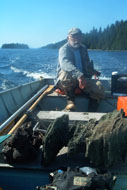
My interests in stone are very broad. When I prospect, it can be for marble for sculptors, suiseki or “natural sculpture,” lapidary stone, crystals, fossils, gold and other valuable ore minerals. Typically, I look for whatever might sensibly be found within the geological context of where I happen to be. You don’t look for peaches in a pine forest. You don’t expect to encounter gold or crystals (excepting perhaps calcite) in a limestone bed; but you do keep a look out for fossils, sculpting stone, and “natural sculpture.” In volcanics, look for crystals and lapidary stone. Almost every geological setting has something of interest.
Month By Month
May
...was Wrangell garnet month. Karen (my partner) and I had the good fortune of a six-day visit to my old Alaskan hometown of Wrangell, where a new museum had purchased a number of items from Stone Arts of Alaska. We were there to install them: an outdoor bench made of Red Jasper Conglomerate, a collection of crystallized mineral specimens from southeast Alaska, and a two-ton boulder of Aphrodite Marble to be used as an entryway “hands on” display piece. We had agreed to polish a section of this fossil-laden boulder when they were ready to set it up for display. The only place in town with the compressed air needed to power our stone working tools was a boat repair shop. (It was nostalgic for me - during the early eighties, I worked there as a shipwright.) Over three days, we polished the stone’s top sides, an area of about four square feet.
When finished, this stone (pictured left) - to be touched and pondered for years by museum visitors - will be a” window” into life on this planet 420 million years ago.
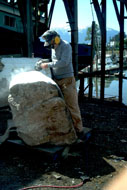
After our work obligations were behind us, we hired a local boat to take us eight miles up the Stikine River to dig for garnets. We stayed two nights at the site in a nearby Forest Service cabin. You may dig for garnets at this famous location by paying the property owners - the Boy Scouts of America – a collecting fee. The garnets, embedded in schist (sounds like a swear word in German), are very hard to extract with hand tools, but we came out with a few. As big as a quarter, the color of red wine, of intricate crystal structure, they are world renowned among mineral collectors. The first mineral specimen I ever purchased, as a North Carolina kid about nine years old, was an Alaskan garnet from this very locality
June
... began with a descent into a long abandoned copper mine to look for mineral specimens. A long time ago, I had been to the surface of this mine and, looking through the rubble of its dump, had found some very interesting copper minerals - bright red cuprite (rare) and green malachite, in delicate little radiating sprays. On our ferry trip north to Alaska this year, Karen and I met a man who told us that he could take us into the old mine itself. He was a caver (spelunker) and had the ropes, lights, and other equipment necessary. He had been inside once before. We entered the upper shaft and climbed down a wooden ladder left from the mining days a hundred years past. We had a rope safety line too, which was most necessary as many on the ladder’s rungs were rotten and broke with our weight. As it turned out, the trip was unproductive – the mine walls were too covered with muck to see any of the mineralization - and also very hard for me because I became ill with giardia, a bacterial infection of the intestines, at the very time I was at the bottom of that hole. Feverish, weak, and somewhat disoriented, I had a hellish time pulling myself up and out to the surface. A doctor gave me a whopper shot of antibiotics the next day.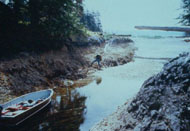
The two trips we did by skiff went much better. I have a fourteen-foot aluminum boat, with outboard, that can be moved by trailer. We put the boat in the water at Hollis, on the east side of Prince of Wales Island (Craig is on the west side). From there, it is a ten-mile boat trip to the island home of “Stingray” fossil coral. The limestone outcropping in which it is found is accessible only from the water and at low tide. With its tight black on white pattern, this material is now in great demand for jewelry. The very best “Stingray” is exceedingly rare.
The boat trip to “Stingray” Island had some special features to remember. On one of our two trips, humpback whales were in the bay and very close by. Blowing alongside, they made us in our little boat seem very, very small. On the way home from our second trip to “Stingray,” we picked buckets of berries on a small nearby island appropriately named Berry Island. Also, we stopped in Coal Bay. We were looking for coal on the beach (since Karen is a blacksmith.) The name Coal Bay not withstanding, we found none. We did find an area of beach that has many watermelon-sized concretions lying about, perfectly round, or virtually so, these are a wonder of nature. “Stingray” Island, about six miles long, has one full-time resident who we always visit. Boots, now in her late 70’s, has lived by herself (with her dogs and cats) in a tiny house for some thirty years. In the summer, she may have a visitor every month or so; in winter, she can go months without seeing another soul. She is one of those independent old time Alaskans whose life and story are of a bygone era. Unfortunately, she is now getting too arthritic to cut firewood and is considering moving to Ketchikan.
July
I love X’s on maps. They are most treasured on my old weather-frayed topographic maps and on my now-yellowing nautical charts. My first stone collecting trip in July was to Kupreanof Island to check out an X on one such map. It was not placed by me but by a man I met fifteen years ago who was contracting to the Forest Service to survey a logging roadway. His X indicated an outcropping of obsidian he had come across. I never had an opportunity to get to the spot, marked about a half mile inland, but I did once manage a brief look at the mouth of a creek that drains the area. I then found one piece of obsidian, which was later made into a sphere. Finally, this July, via a friend’s boat and handheld GPS, I found the outcrop. Vitreous black, with red and green swirls, this obsidian is quite attractive. Regrettably, it has too many fractures to be either carved or knapped. We camped on the beach overnight and walked about the bay’s namesake rock formations, basaltic pillars that reminded some early visitor of totems. The place is named Totem Bay.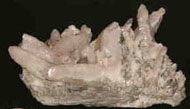
Our second trip in July was via our skiff to Tuxekan Island. Our purpose in going was two-fold. First, I wanted to do my yearly assessment work (as required by law) at my Aphrodite Marble claim. From salt water, the claim is most easily reached by the foot trail I whacked out with a machete some time ago. (The trail does not start until a hundred feet inland from the beach, a precaution taken to prevent people passing by, on boats or casually walking the beach, from noticing it. One has to walk inland from a certain cedar tree marked only in my memory.) The assessment work – flagging the claim boundaries and sampling – completed, we returned to the skiff and motored along the shore another mile or so to collect a stone I call “Red Karheen.” (“Karheen Passage” is the name of the body of salt water there and “Karheen” is the name of an Indian village, now abandoned.) Found only a couple years ago, this stone is a marble conglomerate in which the calcareous cement is dark red and the clasts (pebbles within) are multicolored. We filled the skiff with nice chunks of this stone. Note sculpture done by Jim Heltsley.
Our third trip in July, via pick-up truck, was to Beaver Creek, one of my very favorite natural sculpture collecting locations. It had not rained for a while and the stream was low, making it easy to cross back and forth in rubber boots and allowing a clearer view of stones normally submerged. This stream has a great abundance of water-worn black marble boulders, many with wonderfully sculpted shapes. White calcite veins transect some of the otherwise pure black stones. When the black boulders are shaped like mountains, the white calcite veins suggest flowing streams and waterfalls – suiseki at its best. Picking our way downstream a half mile or so, we placed our best finds on logs, stumps, or large boulders to pick up on the way back out. Hard choices among heavy rocks, we could only carry out a small percentage of our finds.
August
....was a month of incredible good luck. One day, a man stopped in at my stone yard/shop in Craig and identified himself as a bush pilot. He said he owned his own aircraft, indeed his own company, and was in my area of southeast Alaska to do a few weeks of private contract work. He liked some things that I had for sale and asked if I would consider trading for some flight time. Well, how fast can a person say “yes?” Over the next month, we did four trips together.
We first went to my Jupiter Marble location. This is on the west side of an island that faces the open Pacific and is most hard to get to even by boat (see story in web-site under Jupiter Marble). We were able to land the plane on a nearby lake and walk from there. Using my pack-frame backpack, we carried out about 500 pounds of choice pieces. Our second trip was to the same island and lake, but with a walk in the opposite direction, for another marble. I call this one “Yellow Monet,” because of the pastel quality of its colors. (See Other Stone.) Again we loaded about 500 pounds. I was always concerned about overloading but the pilot obviously knew his plane’s weight limits. The third trip was pure prospecting, a first visit to an area that I had always thought promising. But no luck - I found no worthy marble. In this instance, the pilot dropped me off for four hours while he attended his paying clients. I spent most of my time in nearby muskegs grazing on the plump blueberries.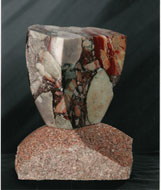
The fourth trip was a hum-dinger. I had the pilot drop me off at a high mountain lake near some long abandoned copper mines. Here the quest was for crystals and lapidary stone. Quartz crystals were abundant. I found some of a rare habit or formation called “Japanese Twins”. In these, two crystals join at their base at a precise 84.33 degree angle. Note crystals in forefront of the picture above.
The lapidary stone consisted of malachite, azurite, and chrysocolla. The old mine dumps were speckled with the greens and blues of these minerals. When cut and polished, these secondary copper minerals make beautiful jewelry stone. I am sure I will be sawing it all winter.
September
...was a good month too. I did two boat trips that were memorable. The first was for a fine colored marble called Pink Chomondeley, named for the bay from which it comes. This marble is fine grained and takes a high polish. It is exceptional in its color of pink. Pink marble is relatively common in this world but most of it is orangish-pink and rather dull. Chomondeley is a crisp raspberry pink, the nicest pink I have ever seen. Being water worn, this marble comes in very suggestive shapes for the carver.
The concluding trip of our summer, an overnight jaunt aboard a seine boat, was to Conclusion Island - to another X on an old nautical chart. This X was for a jasper of extraordinary color - sky-blue. The first pieces of this stone, found fifteen years ago, proved well suited for jewelry. Composed completely of basalts and related volcanic rocks, Conclusion Island also has pockets of crystals, agates, and jaspers of other colors.
October
... was a month of packing and leaving our little place in Craig for the winter. The biggest job is always loading the stone, found over the summer, into the container van I yearly ship south on a barge to my Bellingham facility.
A couple other memorable events took place over the summer of 2004 that I would like to briefly mention. First, my year in Alaska was the best ever at my little stone yard/studio/gallery/stone shop. Simply, it was better because of the people I had working with me. Karen, my partner, made both wooden and wrought-iron stands for my Aphrodite Marble, Prince of Wales Greenstone, and Red Jasper Conglomerate table tops. Her work – her simple but elegant designs - made my work far more marketable.
Karen also deserves credit for much of the work on the web-site. Alissa Norman was my very skillful and personable employee who contributed greatly with her artistically rendered stone hearts, “sun catchers,” mobiles, and jewelry. And, oh, how nice it is to have help with the polishing.
The second event was far less good. I had scheduled for late July a stone collecting trip aboard a rather large charter boat that operated out of La Conner, WA. Although I had never worked with this boat, both she and her crew seemed experienced and capable. Unfortunately, in June, the boat suffered an engine failure in a critically narrow waterway. She was blown within minutes by the strong wind onto a rocky shoal. She was pounded to splinters by the waves. Fortunately, all on board had time to evacuate safely.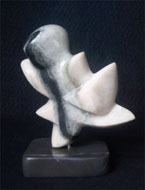
The third thing to mention is that I won second place, out of eighty-seven entries, in a judged art show in Alaska for a little sculpture I completed ten years ago. Called “Happy Go Lucky,” of Chatham Marble, it was my first entry into such a show. I hope you don’t mind me passing along this little brag.

